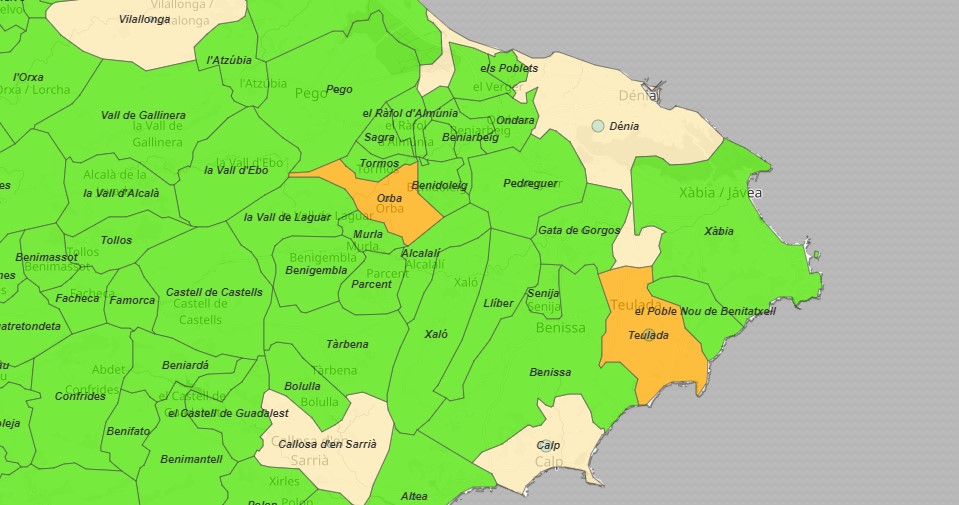VIRUS UPDATE: Infection rate drops in Xàbia as no new positives detected
The municipality drops back into the ‘New Normal’ level as the country prepares for the expiry of the national state of alarm.

Friday 7th May 2021 – Compiled by MIKE SMITH
No new positive cases were detected in Xàbia in the latest update from the regional health ministry whilst the municipality’s 14-day IA rate, a measure of the speed at which the virus moves through the population, has dropped to 17.85 cases per 100,000 inhabitants, which places the town back in the ‘New Normal’ category of infection. Since the pandemic began, 1,456 positive cases have been detected in Xàbia.
Orba (134.41) and Teulada (124.14 – 3 new cases) are the two municipalities in the Marina Alta region that find themselves in the ‘Medium Risk’ category this Friday. Elsewhere Dénia recorded four new positive cases but remain in the ‘Low Risk’ category along with Calp which has detected three new cases; Benissa, Gata de Gorgos and Ondara each detected one positive case but remain in the ‘New Normal’ level. In total, the Marina Alta detected 13 new positive cases of coronavirus but thanfully no new deaths and the region’s toll remains at 202.
Much of the Marina Alta (89%) is coloured green, the ‘New Normal’ level, with most of the 33 municipalities in the comarca having not recorded a new positive case since Tuesday whilst the region’s 14-day IA rate has dropped slightly to 31.65 cases per 100,000 inhabitants, although this is still below the average for all health authorities in the Comunidad Valenciana.
Spain
Spain’s 14-day IA rate is 202.20 cases per 100,000 inhabitants, placing the country in the ‘High Risk’ category. The rate has been dropping steadily for almost two weeks, along with the Positivity Rate, the measure of how many coronavirus tests return positive, which has dropped to 6.68%, its lowest level since the beginning of April; a value of 5% or less would be indicative that transmission of the virus was under control.
Across the autonomous regions, the País Vasco still leads the way with a 14-day IA rate of 463.36, placing it firmly in the highest ‘Extreme Risk’ category along with six others – Madrid, Navarra, Melilla, Aragón, La Rioja and Cataluña – whilst the Comunidad Valenciana (40.99) remains the only region in the ‘Low Risk’ level with the added bonus that active cases have dropped below the 3,000 mark for the first time since last August. Infection spread has been dropping steadily in eight autonomous regions: Ceuta, Melilla, Canarias, Asturias, Navarra, Extremadura, Andalucia and Madrid.
The newspaper El País has reported that the curve has started to fall after a couple of weeks on a plateau but that the uneven control of the virus from region to region as well as the continued high pressure on the health system means that experts remain cautious, especially as the national state of alarm comes to an end this weekend, the legal framework that was required to restrict the movement of citizens, and it is fully expected that there could be dangerous spikes in infections unless regions use the courts to impose appropriate measures, such as the Generalitat Valenciana is doing at the moment. The experts are clear: the more the virus circulates, the greater the risk of new variants.
Fernando Simón, director of the Health Ministry’s Coordination Centre for Health Alerts (CCAES), called for the risk to be assessed on a regional basis and the appropriate action taken on a regional level. “I would not consider equal measures for everyone.”
Daniel López-Acuña, a former director of emergencies at the World Health Organization (WHO), agreed. “It is evident that we are not faced with a uniform situation. There are some regions with major problems and we cannot downplay high incidences just because they are among younger people. There may be a lower level of mortality, but there is still a problem with the severity [of the illness] and the occupation of ICUs.” He added that “we cannot under any circumstance lift the restrictions from one day to the next in those regions that are above 250 cases per 100,000 inhabitants, and that have intense levels of community transmission“.
Vaccination (06.05.21)
Spain has administered 18,489,580 doses of vaccine, which is 87.7% of those which it has already received. A total of 5,696,827 people have completed the recommended course, which is 14.2% of the total of the population which is to be vaccinated (40,129,822).
According to the latest data provided by the health authorities, 81.3% of people aged 60 and over in Spain have received at least one dose, with 35.9% having completed the recommended course.
The Comunidad Valenciana has administered 1,882,334 doses of vaccine, which is 89.9% of the total which it has received. A total of 573,882 people have completed the recommended course, which 13.4% of the population which is to be vaccinated (4,289,305).
According to the latest data provided by the health authorities, 77.8% of people aged 60 and over in the Comunidad Valenciana have received at least one dose, with 35.7% having completed the recommended course.
LINKS
- Actualización nº 369. Enfermedad por el coronavirus (COVID-19). 06.05.2021
- GIV COVID-19 Gestión integral de la vacunación COVID-19
- COVID-19 C. Valenciana: Monitoratge de la situació



